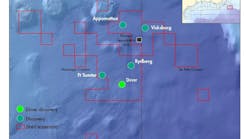David Paganie - Houston
Ike topples old platforms
Hurricane Ike, the ninth named storm, fifth hurricane, and third major hurricane of the 2008 Atlantic hurricane season, has destroyed more of the Gulf of Mexico’s old out-of-date infrastructure. Most of the damage to oil and gas infrastructure was to old platforms on the shelf offshore Louisiana, said Lars Herbst, MMS Gulf of Mexico regional director. The platforms destroyed were installed between West Cameron and Grand Isle in the ’70s and ’80s, Lars said.
Most of the platform damage was likely due to waves, and the pipeline damage was likely not caused by mudslides, he said. MMS says approximately 1,450 oil and gas production platforms were exposed to hurricane force conditions – winds greater than 74 mph and waves 40-50 ft (12-15 m) high.
At print, reports from MMS indicated that 54 platforms were destroyed, 35 had extensive damage, and 60 had moderate damage. For comparison, final damage reports from MMS indicated that Hurricane Katrina destroyed 44 platforms and Hurricane Rita destroyed 64 platforms.
The structures destroyed by Ike produced a total of 13,300 b/d of oil and 90 MMcf/d of natural gas. Eight gas transmission pipeline systems and one oil pipeline system were reported damaged. Enterprise Products Partners said a 42-in. (107-cm) diameter segment of the High Island Offshore System (HIOS), which transports natural gas from various producing fields in the western Gulf, was severed. There was one report of an oil release of 200 bbl. And three jackups and one platform rig were destroyed.
MMS was evaluating temporary barging of oil from damaged facilities, temporary flaring of natural gas, and re-routing of production through existing undamaged pipelines.
The pink shaded area is the approximate region of the Gulf impacted by hurricane force winds (greater than 74 mph). The red dots represent active platforms and the gray lines are pipelines. Map courtesy of MMS.
Fugro Chance Inc. was assisting in the re-positioning of rigs and pipelines, and the inspection of platforms following hurricanes Gustav and Ike. The company has a database that is used to track the location of structures and potential hazards in the GoM. The MMS is using maps generated from Fugro’s database as a basis for their “Notice to Lessees” by which operators must inspect their platforms. One tool that Fugro is using to re-position rigs is called STARFIX.NAV. It is a navigation and positioning system that displays results on screen in real time.
McMoRan contracts Rowan-Mississippi
McMoRan Oil & Gas has awarded Rowan Companies a two-year, $160-million drilling contract for the new 240-C jackupRowan-Mississippi.
The rig will drill one or more ultra deep gas wells, including additional drilling on the Blackbeard prospect.
TheRowan-Mississippi was at Rowan’s Sabine Pass, Texas, facility for final outfitting when it was struck by another vessel caused by a surge from Hurricane Ike as the storm moved through the area. The company’s initial assessment was that the damage is limited and should not delay the rig’s scheduled delivery. The rig was scheduled to be christened on Nov. 1.
Meanwhile, Rowan reported that its jackupRowan-Anchorage capsized and sank at its pre-storm location in Vermilion block 201. The rig was insured for $60 million.
Roxar to supply subsea system for Cascade, Chinook
Petrobras America has awarded a NOK 19.5 million ($4 million) contract to Roxar for the provision of integrated reservoir sensors and multiphase measurement systems for the Cascade and Chinook projects.
The multiphase meter is designed for continuous online monitoring of the flow rates of oil, water, and gas in subsea well streams. Roxar also will install a number of SenCorr SEPT combined sand erosion and pressure and temperature sensor systems, designed to operate in conditions up to 15,000 psi.
Petrobras has selected Roxar’s subsea multiphase meter for real-time monitoring of flow rates in the Cascade and Chinook fields. Image courtesy of Roxar.
The wells on Cascade and Chinook will be drilled in up to 2,650 m (8,694 ft) of water to 8,230 m (27,001 ft) TD.
At such depths with high pressure and flow rates, Roxar’s solutions will provide Petrobras with critical, real-time information on the wells’ capabilities during production, according to Roxar. Information will include water saturation and possible breakthrough, gas coning, permeability and flow characteristics, sand erosion, and pressure and temperature information, the company says.
“We look forward to helping Petrobras move to Phase 2, reducing uncertainties in the reservoir, and maximizing reservoir production, and increase production regularity,” says Gunnar Hviding, Roxar’s CEO.
Roxar’s subsea multiphase meter also comes with a subsea retrievable canister, which houses the meter’s electronics and flow computing modules. Benefits to Petrobras America include low- and cost-effective maintenance with limited subsea intervention requirements, high flow measurement availability, easy installation, and a simplified subsea structure design, according to Roxar.
Semi delivered to ENSCO
A subsidiary of Ensco International has taken delivery ofENSCO 8500, the first of the company’s seven ultra deepwater semisubmersible rigs being built by Keppel FELS in Singapore.
The rig was mobilizing to the GoM, where it will undergo deepwater sea trials and final outfitting prior to its four-year drilling contract with Anadarko and Eni, which is expected to begin in February 2009.
The ENSCO 8500 Series deepwater semisubmersibles feature 8,500 ft (2,591 m) water depth capability, a 2 million pound quad derrick, offline pipe handling capability, automatic station keeping ability, and 150-man living quarters.
ENSCO also reported that it failed to locate its jackupENSCO 74 from its pre-Ike location in South Marsh Island block 149. The rig was insured for $100 million.
Maersk, Chevron sign collaborative exploration agreement
Maersk Oil Gulf of Mexico Three has signed a collaborative exploration agreement with Chevron USA for a multi-well package in the central Gulf. Under the agreement, a number of exploration wells will be drilled in the area over the next few years. Drilling of the first four wells is due to start over the next six months, the companies say. Maersk Oil’s working interest will be about 20%.
Meanwhile, Maersk Oil and Hess Corp. expected to be awarded six exploration blocks where Maersk Oil will hold a 33% interest, from Western Lease Sale 207 held in August.
Subsea 7 wins Droshky pipelines contract
Marathon Oil has awarded Subsea 7 a $45 million subsea pipelines fabrication and installation contract.
The supply agreement is part of Marathon’s previously disclosed procurement activities related to long lead time items associated with the company’s Droshky discovery in Green Canyon block 244. Marathon anticipates sanctioning the development in the fourth quarter.
The contract has been awarded for the fabrication and installation of two 8-in. (20-cm) flowlines totaling 58 km (36 mi).
Subsea 7’s full scope of work on the project includes project management, engineering, fabrication, and installation services associated with the subsea infrastructure, including the flowlines, pipeline end terminations (PLETs), and risers. The pipeline will be fabricated at the company’s new fabrication and spoolbase facility in Port Isabel, Texas.
Engineering work will be carried out from Subsea 7’s office in Houston. The offshore phase of the campaign will be done in 3Q 2009 and will be delivered by Subsea 7’s rigid reeled pipelay vessel,Seven Oceans.







